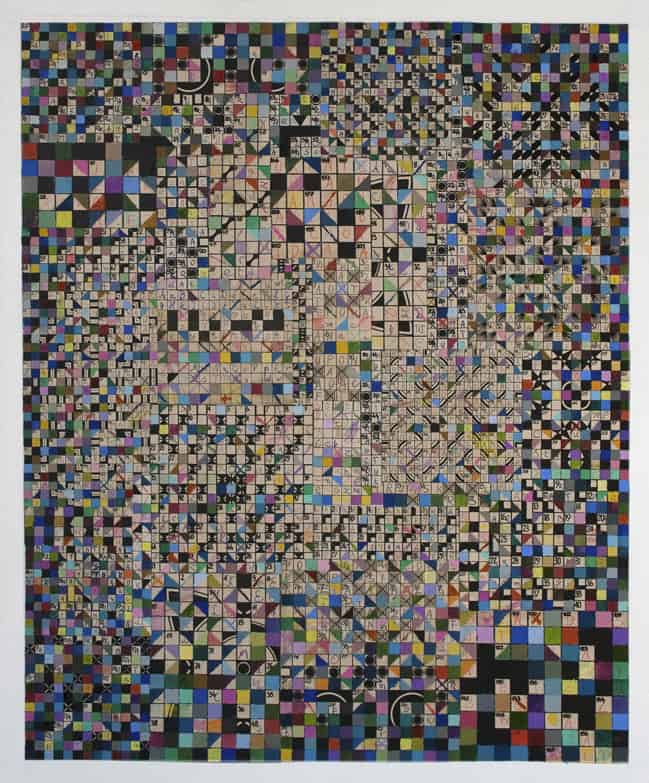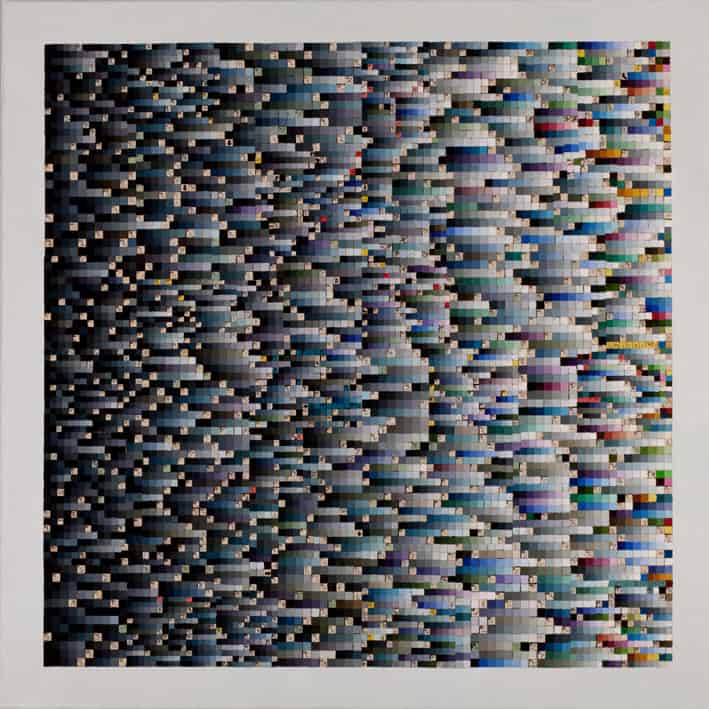Last week we wrote about two exhibitions in Germany — in Bochum and in Marl. This time we check what is happening in Frankfurt.
Mateusz Szczypiński is an artist who made his debut with a series of paintings and collages which made strong references to the traditions of art history. With time, however, his works have started to feature abstract elements which have slowly come to dominate his entire body of work. His latest work can be seen in Frankfurt as a part of the open group exhibition — Contemporay Art from Poland.

Contemporary Art from Poland, exhibition view, 17 March – 19 June 2016, photo courtesy European Central Bank
On things common and uncommon.
Maybe we’re here only to say: house, bridge, well, gate, jug, olive tree, window — at most, pillar, tower … but to say them, remember, oh, to say them in a way that the things themselves never dreamed of existing so intensely.

Mateusz Szczypiński, photo M. Zak
We are here, and Mateusz Szczypiński seems to echo Rilke, not only to attempt to name the nature of things, but also to keep discovering the character of objects, a character which is contrary to the banal role usually ascribed to it. This question about our sensitivity to things results largely from a nostalgia that Szczypiński experiences. It is a nostalgia both for the world of things that he may have dreamt of as a child, and those emerging unexpectedly from the archives of his memory: the control screen on the TV, the first computer pixel images, and tailor’s patterns and crosswords which could always be found in most Polish homes. Further on we encounter associations with the unarticulated childhood dreams about space, about galaxies far, far away; pulsating planets and stars; and memories of filling crosswords in by hand, in times when using pen and paper rather instead of a mouse was commonplace. Objects, ready materials and drawn or painted forms, all of which seem to exude a retro atmosphere. They express nostalgia for a world that not only is slowly becoming extinct, but also constitutes a clear reference to the classics of avant-garde. “Devotio moderna”, “Black Square” bring to mind “the golden age” of violent changes and re-evaluations of art, the impact of which we still experience to this day. Therefore, the stance of artists who were active at the beginning of the last century and who posed questions on the presence of objects in paintings, about the forms and methods of joining and juxtaposing ready-made elements in art is familiar to Szczypiński. An interest in art history, which is not limited to the reception of the works of the first avant-garde, is a common experience of Szczypiński’s generation of artists born in 1980s. Fascination with the past means both the reinterpretation of the works of the masters of modernism, as well as researching the ins and outs of their own memory. Because they are not interested in merely repeating the stylistic of the works created several decades ago, but rather in revealing new contexts and possibilities of reading the heritage of modernity, filtered through their private experiences.

Mateusz Szczypiński, Black Square, 2014, collage, oil on canvas, 90 x 90 cm, photo courtesy the artist and lokal_30

Mateusz Szczypiński, Devotio Moderna I and II, 2012, each: 55 x 55 cm, courtesy the artist and lokal_30
The strategy of recycling used by the artists is not only about the viewer and the artist taking a sentimental journey into the past. In his works he uses old crosswords and tailor’s patterns found in flea markets. The crosswords are filled in — the puzzle had been solved, the mystery is gone and maybe that is what everything is about…We should approach them as a visually attractive material, a certain formal proposal, which allows the artists to contradict its initial function and meaning. Szczypiński is also interested in purely formal matters — pasting, painting over, filling in and combining into surprising combinations, as well as the free associations raised by the “materials” used by him. After all, crosswords are not only word puzzles, but also hybrids created as a result of merging two different specimens in order to obtain a new species.
Colloquially: a crossing is a place where several roads or possibilities meet, where we make a decision about the direction we shall take.

Mateusz Szczypiński, Crossword, 2014, collage on paper, 29,7 x 21 cm, photo courtesy the artist and lokal_30

Mateusz Szczypiński, Crossword, 46 x 38 cm, 2015, photo courtesy the artist and lokal_30

Mateusz Szczypiński, Crossword, 2015, collage, oil on canvas, 60 x 60 cm, photo courtesy the artist and lokal_30
When the artist invites the viewer to think about the “language” he uses: of colours, lines or writings, they become first and foremost a visual sign, a being coming into dialogue with other elements on the canvas. Szczypiński employs already used materials, as if looking for signs of their initial users, pondering over the passing of time, just like Rilke in his Duino Elegy (IX) cited at the beginning: Praise the world to the Angel, not the unsayable: you can’t impress him with glories of feeling (… ) So show him a simple thing, fashioned in age after age that lives close to hand and in sight. Tell him things.(…) Show him how happy things can be, how guiltless and ours, how even the cry of grief decides on pure form, serves as a thing, or dies into a thing: transient, they look to us for deliverance, we, the most transient of all.
Translated by Ewa Tomankiewicz

Mateusz Szczypiński, Crossword, 2015, collage, oil on canvas, 60 x 60 cm, photo courtesy the artist and lokal_30

Mateusz Szczypiński, Crosswords

Mateusz Szczypiński, Crossword, 2014, collage, oil on canvas, 65 x 65 cm, photo courtesy the artist and lokal_30

Mateusz Szczypiński, Crossword, 2015, collage, oil on canvas, 90 x 90 cm, photo courtesy the artist and lokal_30

exhibition view, Dwie lewe ręce Gallery, Katowice








